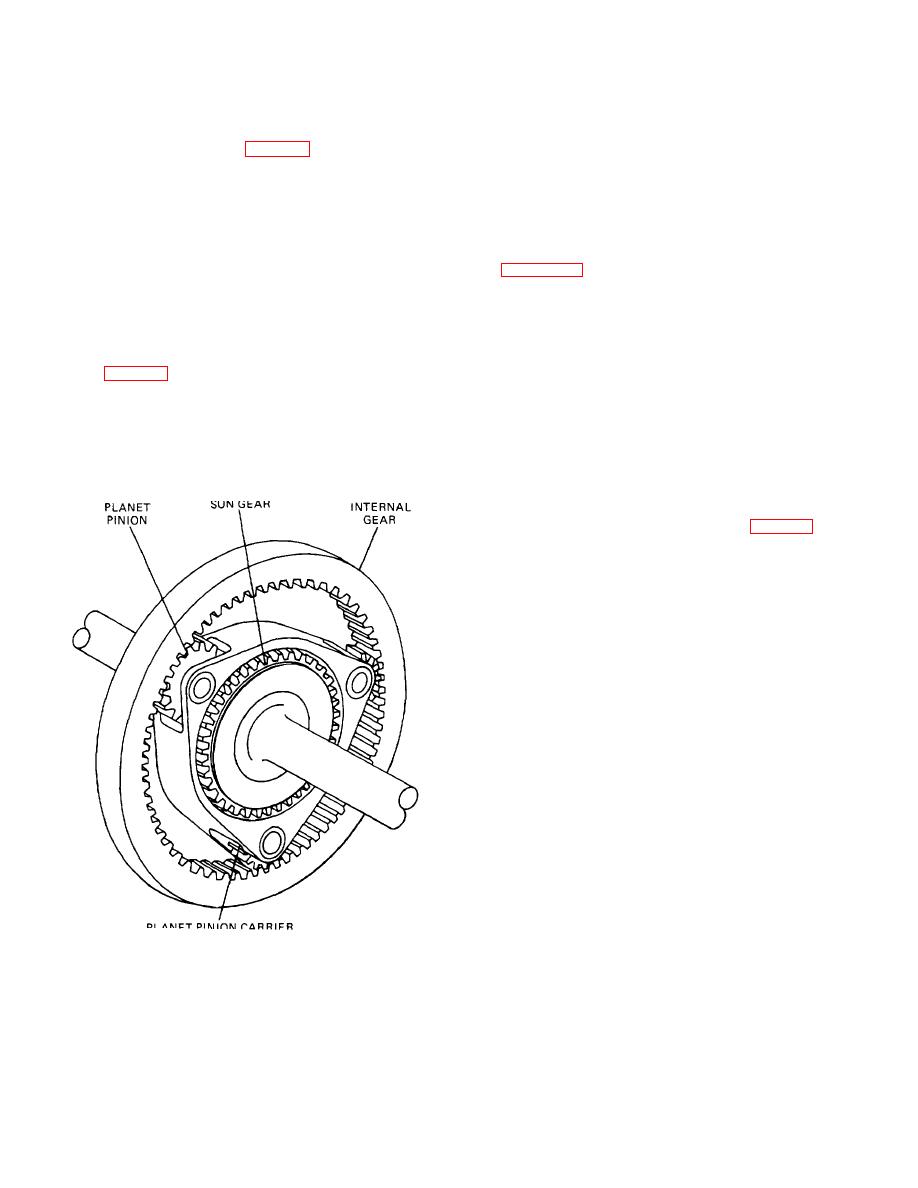
| Tweet |

Custom Search
|
|

|
||
 TM 9-8000
tooth at a time; therefore, they are not able to transmit
and also revolve around the sun. In the planetary gear
large amounts of torque and are noisy during operation.
system, the planet gears are assembled on shafts in a
planet carrier or cage. Arrangements can be made to
e. Worm. Worm gears (fig. 19-5) basically are two
put power into any of the three rotating members and, at
the same time, hold other members so that the gear ratio
different types of gears designed to mesh at right angles
through the system can be increased or decreased. In
to each other. One gear is shaped similar to a helical
addition, by the proper arrangement of turning and
gear, while the other is straight with teeth machined in a
holding, the system can reverse rotation.
spiral form around the exterior of the shaft. Worm gears
only can be driven by the rotating action of the long,
spiral-shaped gear. The spiral-shaped gear also must
19-6. Six Basic Laws of Planetary Gearing. The chart
have a means of absorbing thrust, because the rotating
in figure 19-7 shows the six conditions that can result in
action of this gear causes it to move lengthwise during
the planetary gear system from turning or holding the
operation.
This configuration produces great gear
various members. For example, the column under
reduction and quiet operation.
Condition 1 shows that holding the sun gear while turning
the pinion cage causes the internal gear to turn faster
than the pinion cage. When the pinion cage is turned,
19-5. Planetary Gear Systems. The planetary gear
the pinions must move around the sun gear because
system (fig. 19-6) consists of three rotating members: the
they are meshed with the sun gear. The pinions also are
internal gear (or ring gear); the sun gear; and the planet
meshed with the internal gear, and, as they move around
pinion set, consisting of the planet pinions and the planet-
the sun gear and also rotate on their shafts, they force
pinion carrier, or cage. The reason the system is called a
the internal gear to rotate. The rotation might be said to
planetary gear system is that the planet gears rotate and
come from two sources: the rotation of the pinions on
at the same time revolve around the sun gear, just as the
their shafts; and the rotary motion of the pinions as they
planets in our solar system rotate
are carried around by the pinion cage.
The other conditions listed in the chart (fig. 19-7) are not
all used in automotive power trains, but they should be
studied for a full understanding of the action of the
planetary gear system. If the sun gear is held and the
internal gear turned, then the pinion cage will turn, but
more slowly than the internal gear. If the sun gear is
turned and the internal gear held, the pinion cage will turn
more slowly than the sun gear. On the other hand, if the
internal gear is turned and the pinion cage held, the sun
gear will turn faster than the internal gear, but in a
reverse direction. The fifth condition results if the internal
gear is held and the pinion cage turned; this causes the
sun gear to turn faster than the pinion cage. The sixth
condition is a common one because, by its use, reverse
and gear reduction can be accomplished at the same
time. The sun gear is turned while the pinion cage is
held. This causes the internal gear to turn more slowly
than the sun gear and in a reverse direction.
a bearing is a support for a load. In automotive
applications, bearings support moving parts, most of
which are rotating parts. Not
Figure 19-6. Planetary Gear System
TA233655
19-6
|
||
 |
||